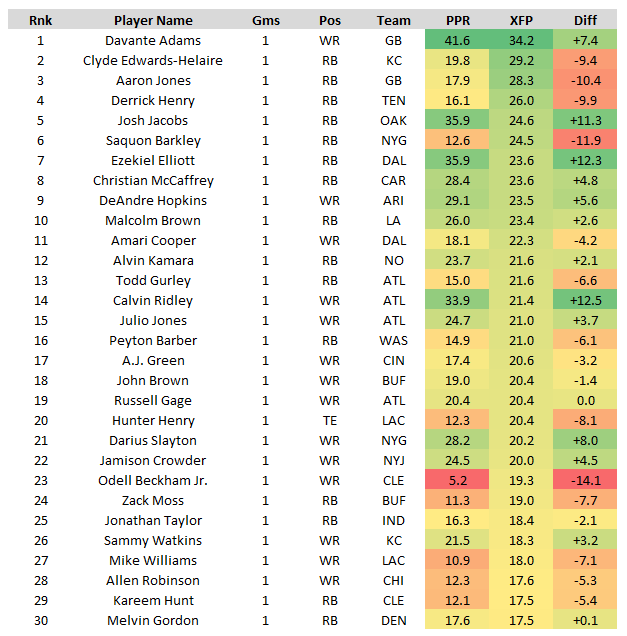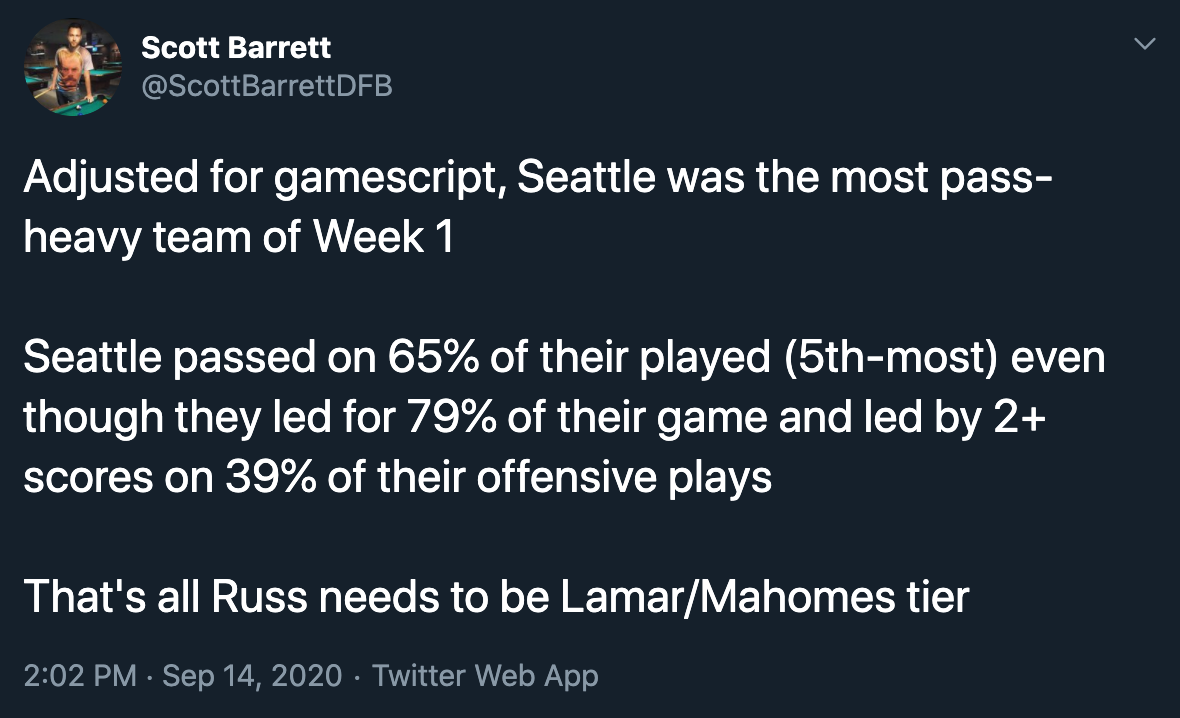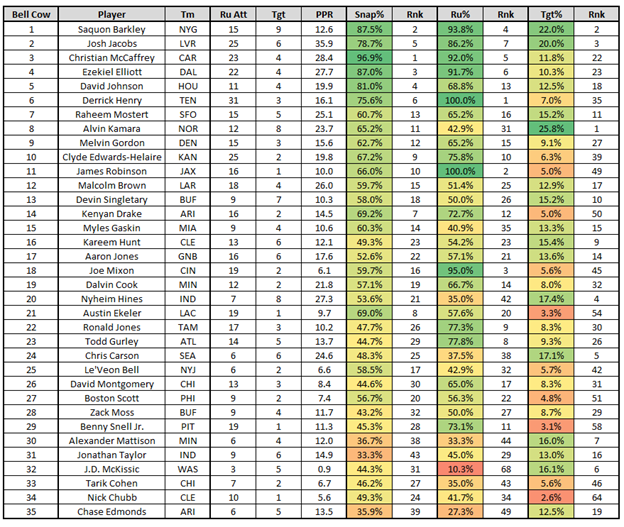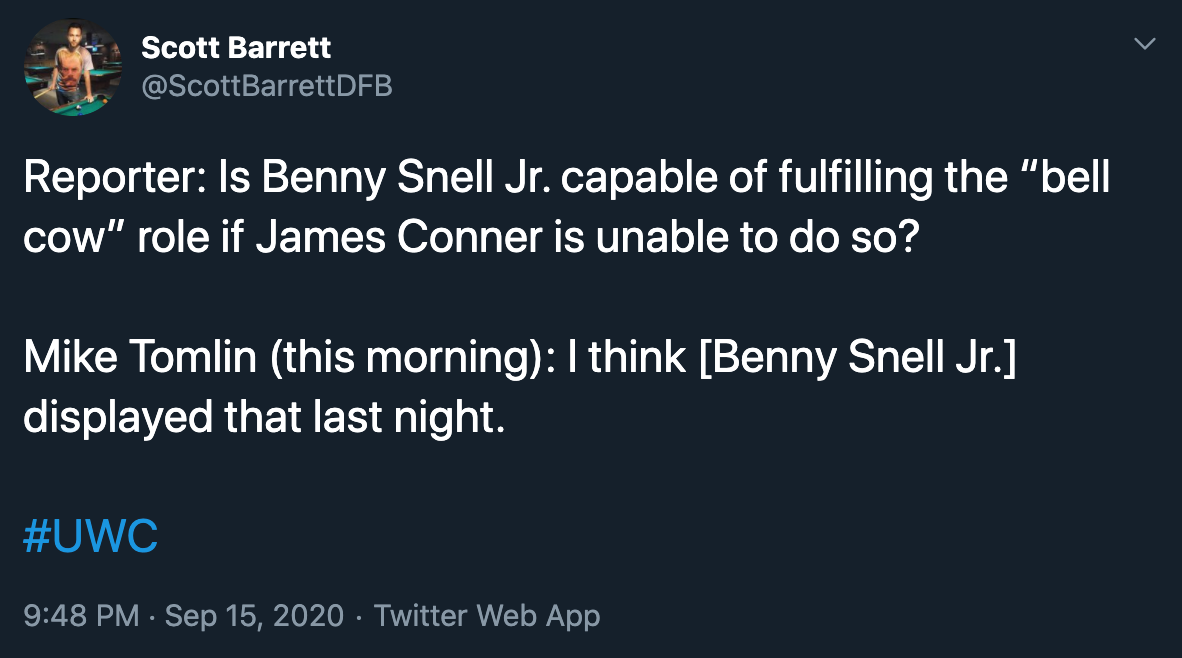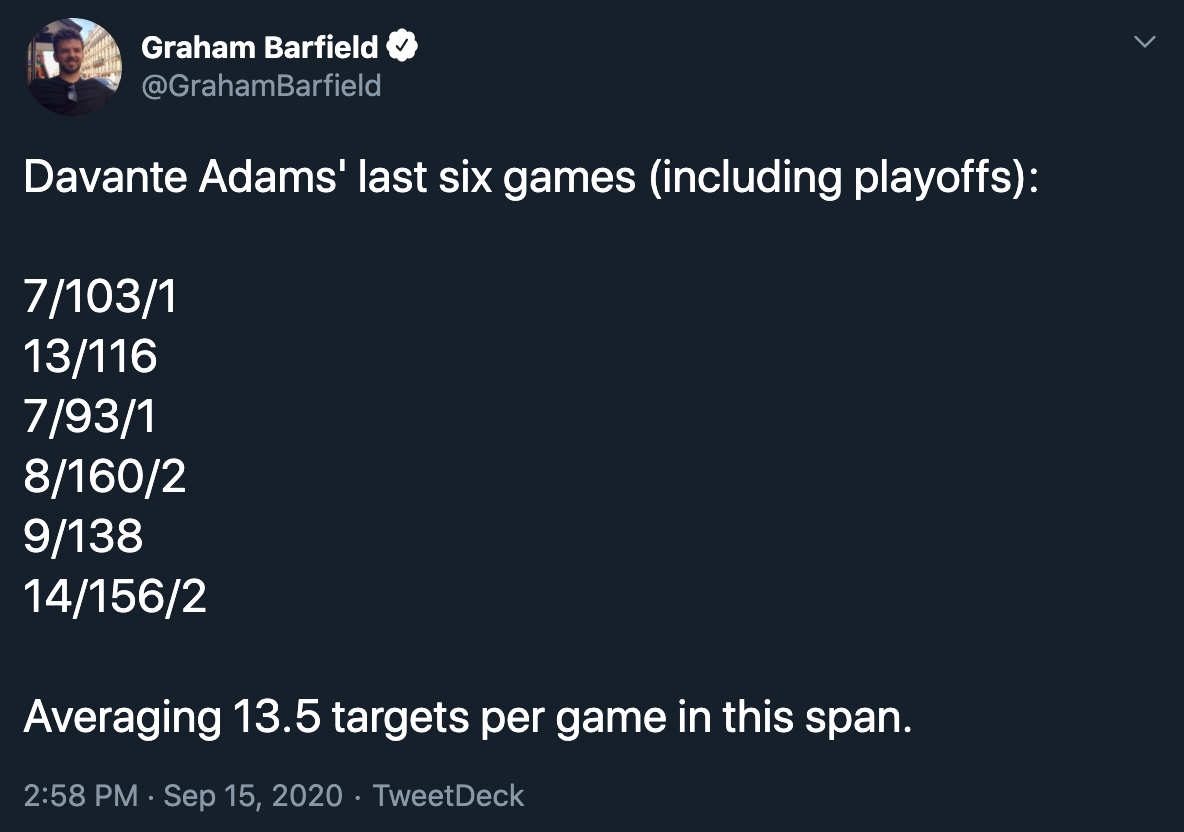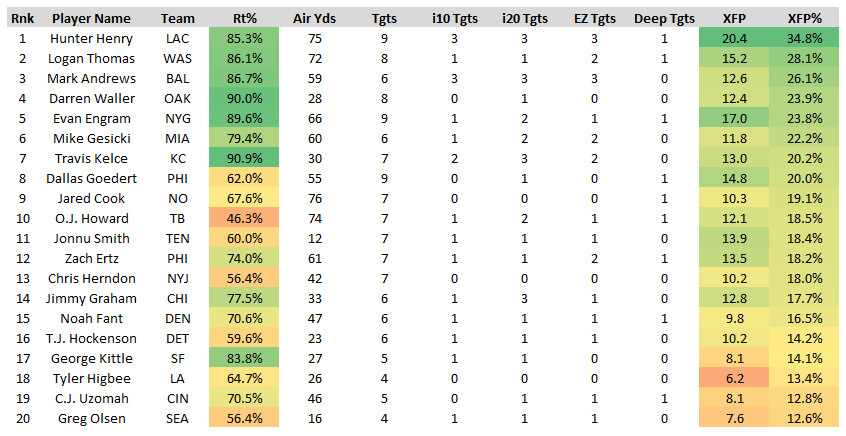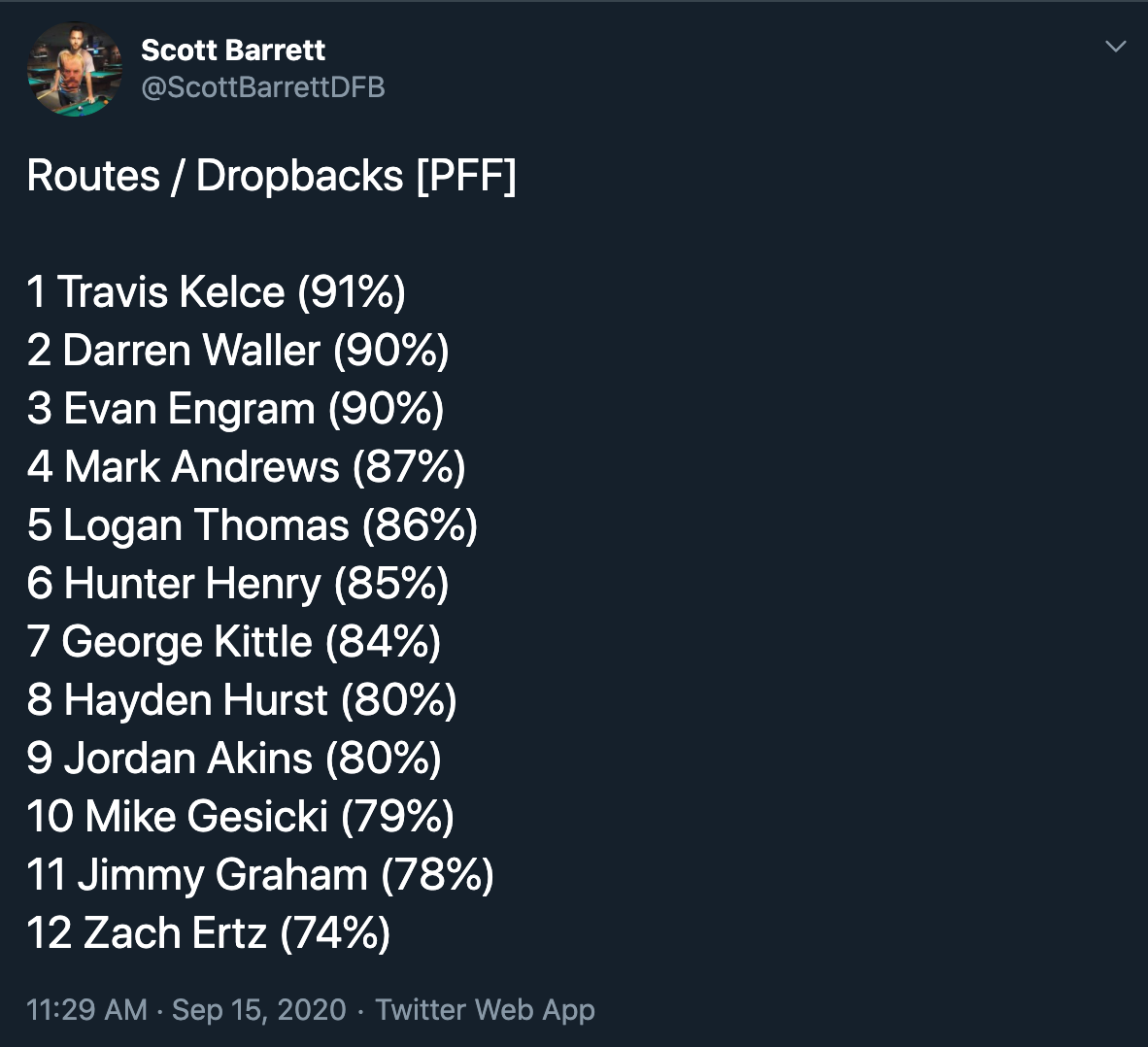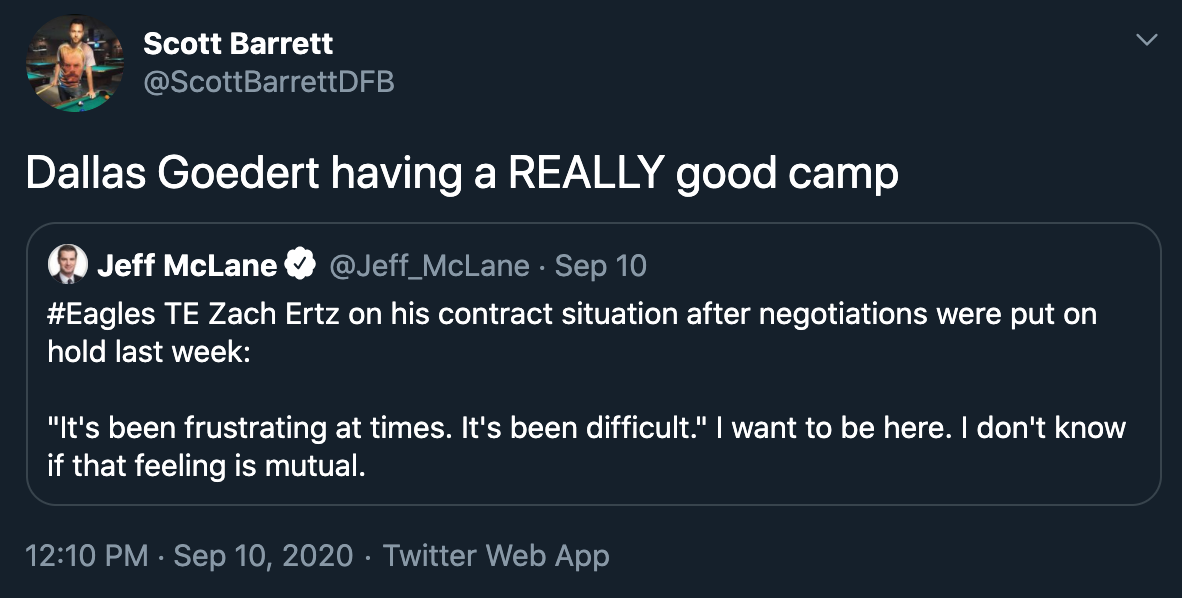Instead of today’s usual article on Expected Fantasy Points (XFP), we’ve decided to go above and beyond for Week 2.
In my experience, fantasy owners are typically too worried about overreacting to Week 1, and not worried enough about underreacting to Week 1. It’s important we don’t get misled by a one-game sample size, but at the same time, if you know what to look for, if you’re able to separate the signal from the noise, are proactive and quick to act, this could be the week where you lay the foundation for a future Championship victory. Today’s article is here to help… Here’s everything (seriously) you need to know from Week 1:
Note: For loyal readers who followed “The XFP Report” at its previous home, you’ll be happy to know that nothing has changed for this article (this week excluded). And better yet – we have all of your favorite XFP-related-stats (e.g. XFP, XTD, Air Yards, End Zone Targets, etc.) live on our site. Keep a lookout for it in the “Research & News” section of our site.
Key Injuries
- Marlon Mack (Achilles, Out for season)
- Le’Veon Bell (Hamstring, Out for Week 2)
- James Conner (Ankle, Questionable for Week 2)
- Justin Jackson (Quad, Questionable for Week 2)
- Duke Johnson (Ankle, Questionable for Week 2)
- Phillip Lindsay (Toe, Questionable for Week 2)
- Michael Thomas (Ankle, Out for Week 2)
- DeVante Parker (Hamstring, Day to Day)
- Blake Jarwin (ACL, Out for Season)
- David Njoku (Knee, Out for Week 2) - George Kittle (Knee, Questionable for Week 2)
- Gerald Everett (Back, Day to Day)
For a more comprehensive look, read the Week 2 Injury Report by Injury Expert Edwin Porras.
Top-30 XFP
What are expected fantasy points?
Expected fantasy points (XFP) is flat-out the best and most comprehensive way of measuring a player’s volume. It’s telling you – based on a player’s unique usage – how many fantasy points that player should have scored. It’s telling you how many fantasy points a perfectly league-average RB, WR, or TE would have scored with that same exact volume. It looks at every individual carry by down and distance and distance from the end zone and every individual target by depth of target and distance from the end zone, and then cross-references each carry and target to each carry and target with those specific qualifiers over a multi-year sample to tell you what exactly those carries and targets are worth (historically). Expected touchdowns (XTD), same thing. RBs score from the one-yard line on 54% of their attempts. RBs score from the 17-yard line only 3.6% of the time. So why ever use “red zone carries,” which treats both carries the same, as a fantasy stat? I have no idea. Why doesn’t everyone point to XFP in their fantasy research? I have no idea. Once you have XFP and TXD you can contrast that with a player’s actual fantasy points or actual touchdown total to tell you how efficient a player has been. This is especially useful in highlighting regression candidates, buy-low targets, and mispriced players for DFS.
Quarterbacks
- Carson Wentz was sacked eight times on Sunday. That’s twice as much as the next-closest QB in Week 1. This could be an issue all season – Philadelphia came into the season with PFF’s highest-graded offensive line but lost Brandon Brooks and Andre Dillard to injury, both out of the year, and was without Lane Johnson for Week 1. Throughout his career, Wentz averages 19.0 FPG when Lane Johnson plays (40 such games) and only 14.9 FPG when he does not (17 such games).
- That’s the bad news on Wentz. The good news is he played like Jameis Winston on steroids. Winston and his receivers were fantasy gold for good reason, namely good high-quality volume. And HC Doug Pederson told us (you can read for yourself at the bottom of this article) that he wants Wentz to maintain that level of aggressiveness all year. Meanwhile, Philip Rivers and Drew Brees were the antitheses of “aggressive” in Week 1, playing like over-the-hill QBs without any remaining arm strength.
- On Sunday, against a tough 49ers defense, Kyler Murray rushed 13 times for 91 yards and a score, while adding 26/40-230-1-1 through the air. This is exactly what you were hoping for when you drafted Murray as a top-five fantasy QB. This was his second career game with 200-plus passing and 90-plus rushing, joining only eight other QBs all-time with at least two such career games. Remember, the Konami Code is real, and it gives a QB like Murray a massive advantage over his peers.
- Speaking of which… Who allowed Bill Belichick to sign Cam Newton (and to a league minimum contract no less)? Newton rushed 15 times for 75 yards and two scores, while adding 155 yards through the air. Is the old Cam Newton back and just as deadly as ever? Maybe. As I argued here, Miami is the ultimate matchup for a mobile QB and no one should be more aware of that fact than Belichick. I’m eager to see what Newton does against Seattle in Week 2.
- In a game that was never in doubt for Buffalo, Josh Allen dropped back to pass 53 times (2nd-most on the week). He found the end zone 3 times (2 passing, 1 rushing), while throwing for a career-high 312 yards on a career-high 46 attempts. On the ground, he added 57 yards on a whopping 14 attempts. Again, Buffalo leaned heavily on Allen even though the game was neither in question. If this sort of volume continues, it’d be hard to argue against Allen as a potential league-winner. That being said, I suspect this was more of a function of the matchup – the Jamal Adams-less Jets are looking like the ultimate pass funnel defense (terrific against the run, dreadful against the pass). The good news for Allen owners is he gets another top matchup this week, against Miami’s man-heavy defense struggles against mobile QBs. He averaged 27.6 FPG against Miami last season and has long been one of the league’s most matchup-sensitive QBs in fantasy.
- Similarly, it seems Seattle has finally #LetRussCook. Russell Wilson went 31/35 with 322 yards and four touchdowns while also leading the team in rushing. Adjusted for game script, Seattle led the league in Pass%, after finishing dead-last in each of the past two seasons. As we argued here, this is all it would take to uplift Wilson to the Lamar Jackson / Patrick Mahomes tier of fantasy quarterbacks. It’s a little too early to know for sure if Pete Carroll has finally unleashed his elite QB, but based on his comments after the game (which you can read at the bottom of this article), I’m optimistic. I don’t know what his MVP odds are, but it's probably low.
- Aaron Rodgers looked like the Aaron Rodgers of old on Sunday, throwing for 364 yards and four touchdowns without any picks. While Rodgers really might be “back” to the Rodgers of old, I’d urge you to remain cautiously optimistic. This was a top matchup against a porous Minnesota secondary, and Rodgers (like Allen) was one of the most matchup-sensitive QBs in the league last season. Quoting a previous article: “Last season Aaron Rodgers averaged 27.8 FPG against teams ranking bottom-6 in FPG allowed to opposing QBs. In all other games, he averaged just 14.3 FPG. For perspective, that’s either 0.4 off of Lamar Jackson for first-place or 0.1 off of Mitchell Trubisky for dead-last among all QBs.”
- Gardner Minshew was lights out for a supposedly tanking Jaguars offense in Week 1, throwing two more touchdowns than he threw incompletions. It’s far too early to call this one a win for Minshew-drafters, but there are at least a few reasons to be optimistic. The typically tempered Greg Cosell hyped up Minshew quite a bit on at least one of our offseason livestreams saying, "I came away very impressed by his tape. I don't know that the Jaguars need to draft a QB next year." In an offseason article, I noted that his 16.8 FPG was the 9th-most by any rookie QB ever. His 27.5 rushing yards per start ranked tied with Deshaun Waston for 4th among QBs. I also noted that Jay Gruden has had a long history of success (for fantasy) with his QBs.
Running Backs
Chart Explained: The above chart ranks running backs by “bell cow usage.” We wrote quite a bit about bell cow running backs, what they are, and why they’re typically fantasy league-winners here. The three highlighted columns are Snap% (% of team’s snaps), Ru% (% of team’s RB rush attempts), and Tgt% (% of team total targets). The column all the way to the left represents a weighted average of those three columns.
NOTE: This was a very unique Week 1. It came after a shortened offseason with limited tackle reps in practice. There were no preseason games. So, keep in mind, it’s not unlikely that we saw players on snap counts that wouldn’t typically be on snap counts (e.g. DeSean Jackson). It’s not unlikely that rookies are going to continue to be eased into playing time. If there were preseason games, some of these rookies would have played quite a bit more in Week 1. On top of that, Arizona at San Francisco was impacted by poor air quality, which may have impacted snap counts for players like Kenyan Drake and Tevin Coleman.
- The “Tony Pollard is too good not to eat into Ezekiel Elliott’s workload” narrative may have been overstated. He, alongside Saquon Barkley and Christian McCaffrey, is looking like a true bell-cow / elite uberbacks that routinely win fantasy leagues. But it seems Josh Jacobs might have joined them, finally seeing the usage in the passing game that Las Vegas beat writers warned us was coming. In addition to 25 carries, Jacobs saw a career-high six targets on a career-high 17 routes in Week 1. This was 77% of Las Vegas’ total backfield routes.
- Bizarrely, elite pass-catchers Austin Ekeler (1 target), Christian McCaffrey (4 targets), and Clyde Edwards-Helaire (1 target) saw shockingly little work in the passing game in Week 1. Meanwhile, Jonathan Taylor – this was a big question mark to his game heading into the season – was targeted six times (for 67 yards) on only 12 routes. The question I’m asking myself – one I wish I spent more time asking in the offseason – is, how much are RB targets a function of the QB rather than the RBs themselves. Studies have shown mobile QBs do tend to target RBs far less than statuesque pocket passers (i.e. Philip Rivers who targeted RBs 17 times in Week 1). Jonathan Taylor may not be a true bell cow at any point this season, but following the season-ending injury to Marlon Mack, and based on Taylor’s natural talent and Philip Rivers’ penchant for targeting RBs, he could be a league-winner. As of right now, I’m pricing him about the same as I am Joe Mixon. It’s still way too early to worry about elite talents like Ekeler, McCaffrey, and Edwards-Helaire, but I would reduce their target projection if I could go back in time today. Teddy Bridgewater and Tyrod Taylor scrambled and broke the pocket far more than Rivers or Carolina’s QBs last season, which means they’re not as often looking for the quick dumpoff to the RB. That also applies to Patrick Mahomes, who is also so strong-armed and talented that he’s probably not thinking about the RBs as often as a Rivers or Brees. The targets will come for Edwards-Helaire and the other RBs (they’re just too good not to be used in the passing game), but this something to keep an eye on.
- I’m guessing related to this broader point, James White ran only 6 routes in Week 1. J.J. Taylor was the only other New England RB to run a route, and he ran just 2 total.
- Arizona’s RB1 averaged 78% of the snaps in 2019. So, Kenyan Drake didn’t quite get the bell cow usage we were hoping for, earning 69% of the snaps, 63% of the backfield routes, and 73% of the RB carries, but the poor air quality in San Francisco may have kept him on the sideline a bit more than what we’d see in a typical game. Or maybe it was the walking boot he shed only one week ago. 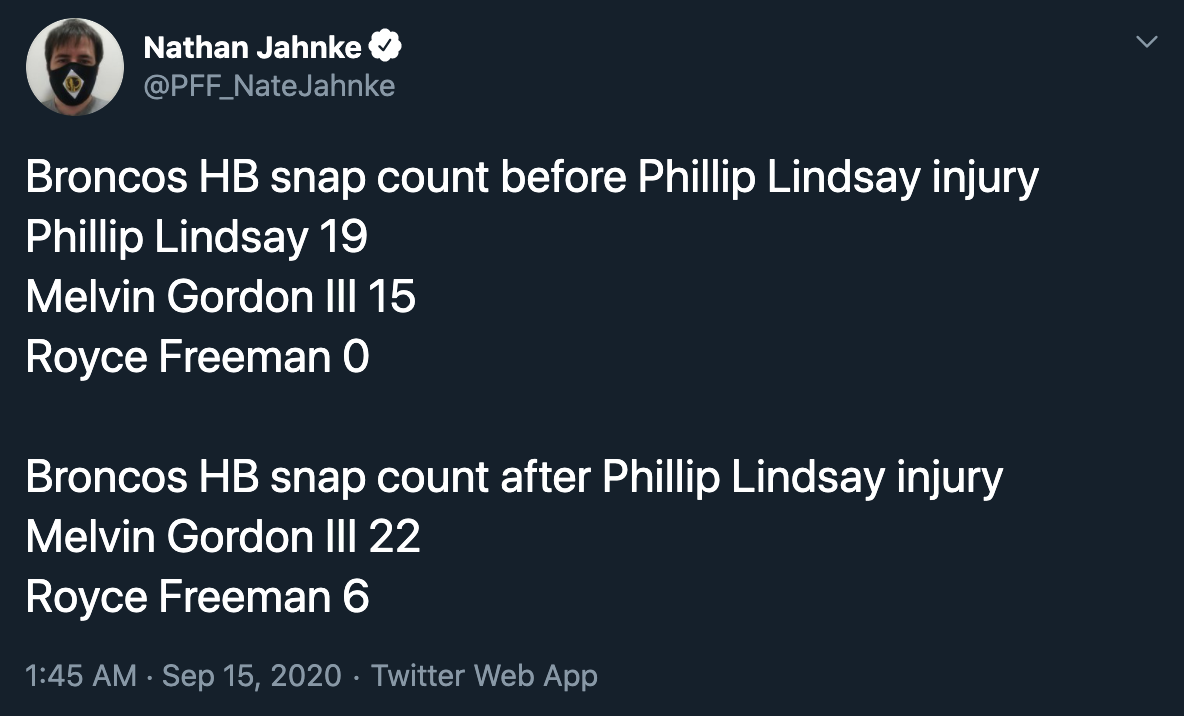
- David Johnson, Melvin Gordon, Derrick Henry, and Raheem Mostert all looked like borderline bell cows, but all four benefited from injuries. Duke Johnson and Phillip Lindsay suffered in-game injuries. Scatback Darrynton Evans missed Week 1. And Tevin Coleman was limited due to a pre-existing condition and poor air quality. Though, that being said, based on Kyle Shanahan’s comments after the game (end of article), Mostert feels to me like a big-time trade target. He won’t ever be a true bell cow, but he probably should be priced closer to the high-end committee backs.
- James Conner was a target of mine for most of the offseason. That had everything to do with price relative to the hyper-valuable “RB1 in Mike Tomlin’s offense”-role that has proved to be so valuable for fantasy. I’m not saying this is likely, but if he’s out for the rest of the season, I’d bet on Benny Snell being a potential league winner. And even if that’s not the case, it’s not impossible Snell carves out a role or maybe even supplants Conner on talent alone.
- As I argued for much of the offseason, Nick Chubb was one of the worst picks you could make at ADP. Kareem Hunt has now out-scored Chubb in 7 of 9 career games with the Browns. He also saw much better usage than Chubb in Week 1, but that was also a function of game script. Chubb is the running back you’ll want to start (roster in DFS) in games Cleveland is favored, and not likely to be trailing throughout (as was the case in Week 1 against maybe the best offense in football).
- Speaking of terrible draft picks, Devin Singletary looks to be stuck in a full-blown committee alongside rookie Zack Moss. Like Chubb and Hunt, both will be game script-dependent. Moss will do better in games Buffalo leads throughout, while Singletary will be better in games Buffalo trails throughout. Though neither will be an exciting or dependable player for fantasy as Josh Allen is effectively the team’s goal-line back, totaling 23 carries inside the 10-yard-line in 28 career starts. - Mark Ingram was a similarly back pick, out-snapped by rookie J.K. Dobbins in both the first-half (11 to 10) and second-half (12 to 11) of Week 1.
- David Montgomery, who came into the game banged up, quietly ran only 4 fewer routes than scatback Tarik Cohen (14 to 18). In a mostly neutral-scripted game, he out-carried Cohen 13 to 7 and out-targeted him 3 to 2. Don’t be surprised if he sees better usage this year. - Rookie RB James Robinson is looking like he “might be a thing,” playing on 66% of the snaps and earning all 16 of the team’s carries, as well as 2 of 4 targets out of the backfield. Chris Thompson’s role was significantly overstated by fantasy drafters, and, based on HC Doug Marrone’s comments (end of article), I’m optimistic Robinson remains a valuable asset. - When Miami signed Jordan Howard, they made him (at the time) one of the 10-highest-paid RBs of the 2020 season, but it was the Myles Gaskin show in Week 1. He earned 60% of the snaps, 41% of the carries out of the backfield, and 67% of the targets out of the backfield. He’s pretty low-upside, but he's going a bit too overlooked by most Waiver Wire-related content I’ve read this week. - D'Andre Swift led the Lions backfield in routes run (23 to Adrian Peterson's 9 and Jamal Agnew's 6). For the foreseeable future, he's likely to perform better in negative game script (when Detroit is trailing).
- Hyped-up rookies Cam Akers and Antonio Gibson “disappointed” in Week 1, but there is quite a bit to be excited about. Malcolm Brown undoubtedly far outplayed the rookie, but Akers did earn 15 touches along with the start. Sean McVay’s comments (end of article) imply to me that this will be a committee backfield until (hopefully) Akers separates from the pack. Similarly, Gibson saw only 11 touches, but he also led the team in rushing yards. His 4.00 YPC far exceeded that of Peyton Barber (1.71) and J.D. McKissic (-0.67). Remember, this is a weird year with a shortened offseason and no preseason games. And, besides, if you drafted names like Akers, Gibson, and Swift it wasn’t for what they would do in Week 1. The hope is borderline-bell cow usage by some point around midseason.
Wide Receivers
Chart Explained: The above table lists all wide receivers in descending order by receiving expected fantasy point (ReXFP) market share as a percentage of the team’s total receiving expected fantasy points. Basically, this is just like target share with targets replaced by XFP generated as a receiver. - Davante Adams caught 14 of 17 targets for 156 yards and two scores. Adam Thielen caught six of eight targets for 110 yards and two scores. DeAndre Hopkins caught 14 of 16 targets for 151 yards and zero scores. True alpha WR1s, without much competition for targets, and because they line up all over the field are fairly matchup-proof. If you drafted these guys you have to feel pretty good about it.
- Of course, Jamison Crowder did have a good matchup against a Buffalo Bills defense he has historically dominated, but it is noteworthy he had arguably the 6th-best usage of any WR this week. Over the past two seasons, Crowder averages 14.8 FPG, 8.6 targets per game, and a 25.4% target share in games Sam Darnold was active. Those are low-end WR2 numbers.
- DeVante Parker feels like a buy-low. In spite of a tough cornerback matchup, in shadow coverage against Jason McCourty, QB Ryan Fitzpatrick looked his way early and often… That is at least until he suffered an injury that sidelined him for the remainder of the game. But, on just 12 routes in a tough matchup, Parker caught all 4 of his targets for 47 yards. If he’s out for an extended time, Preston Williams becomes more interesting. Parker and Mike Gesicki’s splits are night and day after Williams was hurt last season.
- Calvin Ridley was a garbage time superhero in Week 1. In the fourth quarter alone, Ridley scored 28.4 fantasy points on 9 targets. Through the first three quarters he totaled 8.6 on 3 targets.
- In a game that was never close, Marquise Brown sleepwalked his way to a 5-101-0 line in the first half on five targets and only 14 routes.
- Anthony Miller is receiving a lot of buzz for his very impressive Week 1 performance, but it’s important to note he wasn’t a full-time player, running a route on just 55% of Mitchell Trubisky’s dropbacks. He’s someone I’d think about selling high, though an Allen Robinson trade could quickly jack up his value.
- In a tough matchup in shadow coverage against Marlon Humphrey, Odell Beckham Jr. finished the week ranked 8th in targets, earning 10, but catching just 3 for 22 yards. That also doesn’t tell the full story – he had four additional targets called back due to penalty. 14 targets would have ranked 3rd-most on the week. QB play is a concern, but he’s looking like a potential buy-low (especially based on HC Kevin Stefanski’s comments) and Week 2 DFS sleeper.
- DeSean Jackson and Jalen Reagor ranked 1st (210) and 6th (144) in air yards, despite both running a route on only 60% of Carson Wentz’s dropbacks. On Monday, Pederson was asked what went into the decision to limit Jackson. Pederson responded, “Obviously he's a big part of the offense, but at the same time, we want to make sure that he's a guy that's healthy and fresh for us down the long haul here. I think each week, I would anticipate his rep count to increase as we go, and we're going to be smart with him but we also know that he's an explosive receiver for us and we want to get him on the field as much as possible moving forward.” - WR3s Scotty Miller and Greg Cosell favorite Russell Gage impressed in Week 1. Miller totaled 73 yards on six targets, while running a route on 78% of Tom Brady’s dropbacks. In the 10 games since Mohamed Sanu was traded, Russell Gage has averaged 7.8 targets per game.
- Although talent-wise Dallas might have 3 WR1s on offense, Amari Cooper was clearly the team’s true WR1 on Sunday night. He saw a whopping 14 targets despite facing off against Jalen Ramsey on a number of routes. CeeDee Lamb (6) and Michael Gallup (5) ranked 2nd and 3rd on the team for targets, a good distance behind.
- A number of rookie WRs saw good volume in Week 1. In order, Quintez Cephus (9 targets), Jerry Jeudy (9), CeeDee Lamb (6), Henry Ruggs (5). Jalen Reagor saw high-quality targets, ranking 6th in air yards. Laviska Shenault added 2 carries to 4 targets. Chase Claypool caught two balls for 39 yards on just 7 routes. Although I’m not sure if it’d be wise to start any of these rookies in Week 2, there’s a good chance we could be counting on at least a few of these high-profile players down the stretch. Remember, rookie WRs tend to see a massive jump in volume and production in the second half. Don’t be so quick to drop one of these players if they’re slow to produce.
Tight Ends
Chart Explained: This is basically the same chart as the one from the WR section, except the column to the left (Rt%) was added. This represents routes run as a share of the team’s total dropbacks. - So, uh………. Mark Andrews might be a league-winner. He ran a route on 90% of Lamar Jackson’s dropbacks in Week 1. In 2019, he sat at just 63%, with a season-high of only 73%. Allow me to illustrate the impact of this stat. So, last year he finished as a top-five fantasy TE averaging 13.9 FPG. Again, this was on just 63% of Jackson’s routes. A 90% route share would imply 19.9 FPG, or what would rank second all-time, behind only Rob Gronkowski’s famed 2011 season.
- The good news for DFB favorites Jonnu Smith and Chris Herndon is that both players saw seven targets. The bad news is neither did very much with that good volume, and worse yet, neither saw the field as much as we would have liked. Smith ran a route on only 60% of Ryan Tannehill’s dropbacks (23rd). Herndon ran a route on only 56% of Sam Darnold’s dropbacks (56%).
- “Swing for the fences” picks in Tyler Higbee, Rob Gronkowksi, and Irv Smith Jr. aren’t looking so hot either. Higbee saw 13% of the targets on 65% of Jared Goff’s dropbacks (even with Gerald Everett missing some snaps due to the injury). Across the final five weeks of last season, Higbee earned 26% of the targets on 73% of the dropbacks… Gronkowski saw three targets on 51% of Tom Brady’s dropbacks, while O.J. Howard saw six on 46%… Smith saw one target on 52% of the dropbacks. Kyle Rudolph saw two targets on 48% of the dropbacks.
- Logan Thomas could be a thing. Maybe. He ranked second in XFP (15.2), second in XFP% (28%), and fifth in route share (86%). While, of course, this is also the same player who came into the game with 317 career yards in six seasons in the NFL, keep in mind Washington really doesn’t have much else to work with. From 96 Stats, “Among all receivers on Washington’s roster, only one other player (besides Terry McLaurin) has ever recorded over 35 receptions in a single season (Dontrelle Inman, 2016).”
- Dallas Goedert (a longtime favorite of mine) might be a big problem for Zach Ertz and his fantasy owners. Goedert saw a team-high 9 targets in Week 1, catching 8 for 101 yards and a score. Zach Ertz’s 18 yards on 7 targets seems far less impressive in comparison. Though, Ertz is still the TE1 on the team, running a route on 74% of Carson Wentz’s dropbacks to Goedert’s 62%. Keep in mind, however, that’s a dropoff for Ertz (85% in 2019) and an increase for Goedert (59% in 2019). If, somehow Ertz gets traded, it wouldn’t shock me to see both TEs finish as mid-range TE1s at worst.
Key Quotes
Reporter: Is Benny Snell Jr. capable of fulfilling the “bell cow” role if James Conner is unable to do so? Steelers HC Mike Tomlin: I think [Benny Snell Jr.] displayed that last night.
Rams HC Sean McVay (on Malcolm Brown and Cam Akers): see here
Raiders HC Jon Gruden: I like the unselfishness of our offense. We were balanced yesterday. I think we threw 30 times; we ran it 30 times, we had nine different receivers. So, not anybody is going to catch 16 passes in the way we distribute the ball, but I thought overall it’s a good start.
Gruden (on Josh Jacobs): I’m not going to put any more pressure on him than he puts on himself. I’ve been the son of a backfield coach my whole life. My dad coached at Tampa Bay, at Notre Dame. I’ve seen a lot of running backs for a long time, but that was a little bit like Walter Payton used to play. It was hot as hell, he got beat up early. He insisted on coming back, he insisted that he get the ball, as a runner and receiver. He’s special. He deserves some national attention; I hope you guys give it to him.
Lions OC Darrell Bevell: We like all three of those guys, obviously. They all bring a little bit (of) different pieces to the puzzle. There was some situational football in there that elevated some guys’ snaps – so just the way we’re using them. I think we can continue to see that rotation a little bit. Obviously you start getting the guy with the hot hand, and Adrian (Peterson) was running really well in that last game, so he got a few more carries in there as well. So we’ll kind of continue to go in that area. We really like all three of those guys, but we’re going to try to – I always say, we’re going to try to put them in the best spots to help them be successful.
Reporter: You had 17 passes and receptions to running backs. Is maybe the running game complemented by using the running backs in the passing game?
Colts HC Frank Reich: Yes, that’s part of the answer, but part of the answer is we do just want to have more runs. I think what you’re observing or putting together is very true, that getting the backs touches whether it’s handing it off to them or throwing it to them is a way to get them involved in the offense. Now with that being said, there is still something about the physicality of the run game that dictates the tempo and the feel of the game. That’s where we need to be more patient with the run game. I need to continue to call runs even though I know we can be dynamic in the pass game.
Reporter: With the running backs, would you assume Jonathan Taylor sliding into the starting role and maybe Jordan Wilkins takes on a little bit of an expanded role?
Reich: Yeah, that’s exactly right. Jonathan (Taylor) will step into the starting role. He looked good yesterday. Again, I won’t go into it with Marlon (Mack), but such a big loss and so upset for Marlon. But Jonathan is ready. He’ll step up and he’ll do a great job. Nyheim (Hines) is still going to be an important part of the mix – on all downs, not just on third down. But then Jordan (Wilkins) will step up. We’ve got a lot of confidence in Jordan. I’m a big Jordan fan. He’s an excellent runner and he’ll do a good job for us.
Browns HC Kevin Stefanski: [Odell Beckham Jr.] is a good football player so we want him to touch the ball. I think that is good for us. We are mindful of all of our players in terms of how they are touching it. There were opportunities early where the coverage took it away, somebody else was open or those types of things. He is a good football player so I do not think it is newsworthy that he is a focal point of our offense.
Reporter: Curious why WR DeSean Jackson only played 54 percent of the snaps yesterday?
Eagles HC Doug Pederson: Obviously he's a big part of the offense, but at the same time, we want to make sure that he's a guy that's healthy and fresh for us down the long haul here. I think each week, I would anticipate his rep count to increase as we go, and we're going to be smart with him but we also know that he's an explosive receiver for us and we want to get him on the field as much as possible moving forward.
Pederson (on Wentz’s aggressiveness): As far as the aggressiveness goes, I'm still going to maintain the aggressiveness. Look, as I said this morning, a 17-0 lead or a 27-10 lead, in any football game in this league is not enough, and you have to continue to maintain aggressiveness. You have to -- especially when you have momentum, right, and it's kind of on your side. You've got to use that to your advantage, and my thinking at that time, too, was to try to get points before half with the ball to start the third quarter. We've done that many times here where we've scored and then come out and scored touchdowns to start the third quarter. That's a lot of my mindset in these games.
Pederson (on CB Darius Slay shadowing): I think you look at another one with [CB] Darius Slay who matched up with [Washington Football Team WR] Terry McLaurin yesterday, and you know, as we go each week, there's going to be that one receiver that Slay is going to go up against and he did an outstanding job yesterday.
Buccaneers HC Bruce Arians (on RB Leonard Fournette): I think his role will continue to increase. RoJo, I thought, had a really decisive day. He ran hard and made yards when there were no yards to be made a couple of times. Leonard’s role will increase and we’ll just see how much.
Arians (on Mike Evans): [Paraphrased] Should have moved him around more and got him more targets. Shouldn’t have less than 10 targets in any game.
Reporter: I know you've said in the past you don't really care who starts at running back, that doesn't matter. RB Raheem Mostert did get his first start yesterday. What went into that decision and what kind of improvements have you seen from him, even just in this camp and this year?
49ers HC Kyle Shanahan: I think Raheem just earned it last year. The way he came on in the middle of the year, the way he finished the year. I think every running back would agree with me also that Raheem earned that. If you talk to [RB] Tevin [Coleman], you talk to [RB Jerick] Jet [McKinnon] and [WR] Jeff [Wilson Jr.], I think they would agree. So, he earned it. He went out there and kept doing what he did last year. I thought Raheem did have a good game. We got him going on a couple of things. Did a good job in the pass game, too, so I was excited for him.
Jaguars HC Doug Marrone (on RB James Robinson): All I can tell you is what I see the guy do on the field, and unless he just, for lack of a better term, ‘poops the bed’ when the lights are on, I feel that this guy is going to be a good football player.
Reporter (Paraphrased): Are the number of passes a sign of things to come for the offense?
HC Pete Carroll: I think it's just a sign of how we've worked in this off-season and like I said it three or times already, it's really the way we've been practicing and Russ was in total command of the game and had a beautiful game. But there's so many things that factor in on that. Schotty making the calls, all the preparation to get there, it's the guys coming through with their plays and all that, Russ will be the first to tell you. It is a statement, though, off the off-season, that this whole Zoom season, our guys did a marvelous job. Russ was extremely involved, integrally involved with all of that and it just showed. It showed. We were together and tight and functioning well. I don't know what we did on third down, I don't know if it was any good. Even backed up with penalty situations or sacks, we came back and converted. That's confidence and belief. These guys, first game, they have earned their way right here. They have earned their way to play like that by the way they practiced.”
HC Pete Carroll (on RB Chris Carson’s involvement in the pass game): Chris will continue to be a target for us. He's just too good at it. He's really a natural catcher.
HC Pete Carroll (on RB usage as a whole / RBBC): I don't know what the numbers came out today, but it felt good. It felt good giving those guys the chance to keep them fresh. Those were two guys that hammer the football and T-Home was such a good change of pace, I just like the three-guy rotation. Again I don't know what the numbers were today but it felt good. Imagine how much fresher you can keep a lead guy that doesn't have that opportunity, and so we'll just go one game at a time right now. We don't need to call it any way -- never have, and I don't think there will be a time in the season where I'll tell you, oh, this guy is going to get all the snaps or this guy is not. I don't think that's what's going to take place. We'll just keep moving through the game and see what's happening and the style of plays and the runs and all, and I thought we ran the ball well today. We didn't run the ball a lot but we ran the ball well when we did and really pleased with that.


